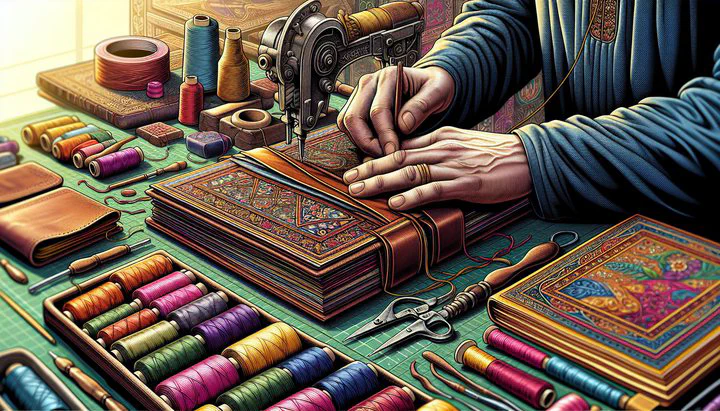Sources on Pre-Industrial Bookbinding

Introduction to Pre-Industrial Bookbinding
Have you ever imagined what it’s like to bind a book just as they did centuries ago? This is the world of pre-industrial bookbinding, where every page and cover was painstakingly put together by hand. Before the age of machines, bookbinding was an art form filled with charm and skill, where artisans took pride in their work. Understanding these old school techniques not only connects us to history but also offers a refreshing escape from the fast-paced digital world.
In the days before industrialization, bookbinding was a slow and meticulous process. Craftsmen, sometimes working in dimly lit workshops, would bind books using methods passed down through generations. They used simple tools and natural materials, like leather and handmade paper, to create beautiful, functional books. These techniques are quite different from modern methods, which rely heavily on machines and synthetic materials. Today, many people find joy in rediscovering these traditional skills and learning to “learn it the slow and hard way”.
So, why should you, as a craft enthusiast, care about these ancient ways of bookbinding? First, mastering these techniques can be incredibly satisfying. It allows you to create something unique and personal with your own hands. Moreover, understanding the history of bookbinding gives you a deeper appreciation for the books we often take for granted. By exploring sources on pre-industrial bookbinding, you can uncover the rich stories behind each stitch and fold, and perhaps even inspire your own creative journey.
Essential Resources for Learning Traditional Techniques
Ready to dive into the enchanting world of pre-industrial bookbinding? To truly master these old school techniques, you’ll need to explore a variety of resources that offer detailed insights and guidance. While it might seem daunting at first, discovering the right materials can make your journey both educational and enjoyable.
One of the best places to start is with books, museum pamphlets, or literally anything else that delves into the art of bookbinding before the industrial era. A classic resource is “The Archaeology of Medieval Bookbinding” by J.A. Szirmai. This book provides a deep exploration of historical techniques, complete with illustrations that show how books were constructed in different times and places. It’s a treasure trove of information that can spark your curiosity and guide your hands as you practice.
Another helpful resource is visiting museum collections or libraries that hold antique books. Many museums offer detailed pamphlets or guides that explain the history and methods used in binding these ancient texts. For hands-on learners, these pamphlets can be particularly helpful, allowing you to see the materials and techniques up close.
Don’t forget the value of online communities and forums where enthusiasts share their knowledge and experiences. Websites like The Craft Chronicle and subreddits such as bookbinding are great places to find recommendations for good sources on pre-industrial bookbinding techniques. Here, you can connect with others who are passionate about the craft and learn from their journeys. Sharing stories and tips with a community can make the learning process more engaging and supportive.
By using a mix of sources on pre-industrial bookbinding, you can gain a comprehensive understanding of the craft. Each resource offers unique insights, helping you to piece together the puzzle of how books were bound in the past. So gather your materials, dive into these resources, and prepare to learn it the slow and hard way. It’s a rewarding adventure that connects you with a rich tradition of creativity and craftsmanship.
Practical Insights from Practicing Old School Techniques
Embarking on the journey to master pre-industrial bookbinding can be both exciting and challenging. If you’re ready to dive into these old school techniques, there are a few practical tips that can help you along the way. Remember, the key is to learn it the slow and hard way, embracing the process and the patience it requires.
First, start small and simple. Begin with a basic project, like a single-section book, to get used to handling materials like leather and handmade paper. As you gain confidence, gradually move on to more complex bindings. This approach allows you to build your skills step-by-step without feeling overwhelmed. It’s okay to make mistakes—each one is a learning opportunity that brings you closer to mastering the craft.
Connecting with a community of fellow enthusiasts can be incredibly helpful. Share your experiences and challenges on forums like bookbinding on Reddit or in local crafting groups. Here, you can exchange tips, troubleshoot problems, and find encouragement from others who are also passionate about this ancient art. Community support can transform your learning experience, making it more enjoyable and less isolating.
Don’t rush the process. Take the time to savor each step, from cutting the paper to stitching the spine. Pre-industrial bookbinding is as much about the journey as it is about the finished product. As you work, you’ll develop a deeper appreciation for the intricate details and the stories behind each technique. This slow, deliberate approach not only improves your skills but also enriches your connection to the craft.
Finally, don’t be afraid to experiment with different sources on pre-industrial bookbinding. Try out methods you’ve read about in books, museum pamphlets, or literally anything else you’ve discovered. Each source offers a unique perspective or technique you can incorporate into your work. By blending these insights, you can create something truly unique and personal.
As you practice, remember that the art of pre-industrial bookbinding is a journey of continuous learning. Embrace each challenge, celebrate your successes, and enjoy the tactile pleasure of crafting something with your own hands. Share your projects with us at The Craft Chronicle or join a subreddit like bookbinding to connect with others who share your passion. With dedication and curiosity, you’ll find that these old school techniques bring not just skill, but a deep sense of fulfillment and connection to history.